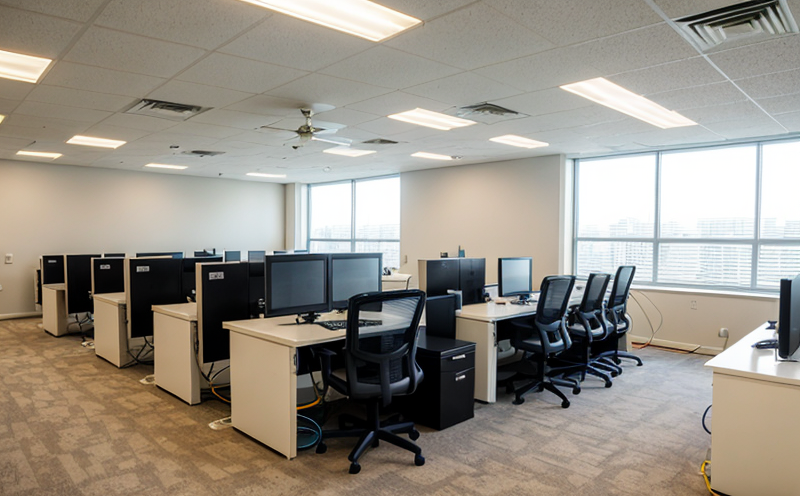EN 62471 Energy Safety Certification Testing of Photobiological Aspects
The European Standard EN 62471 specifies the photobiological safety requirements and test methods for lamps, luminaires, and similar equipment. This standard is crucial in ensuring that lighting products do not emit excessive amounts of ultraviolet (UV) or infrared (IR) radiation, which could pose a risk to human health.
The testing under EN 62471 involves the measurement of photobiological safety parameters such as blue light hazard (BLH), eye irritation and discomfort (EID), and skin irritation (SI). These tests are essential for compliance with international regulations and ensure that lighting products meet stringent safety standards. The standard applies to various types of lamps, including LEDs, CFLs, halogen bulbs, and other electric lights.
Our laboratory specializes in performing comprehensive EN 62471 testing services. We use state-of-the-art equipment and follow strict procedures to ensure accurate and reliable test results. Our team of experts is well-versed in the latest testing methodologies and can provide detailed reports that meet your specific requirements.
The importance of photobiological safety cannot be overstated, especially given the increasing prevalence of LED lighting technology. These lights are known for their energy efficiency but also emit blue light, which may cause eye strain or other health issues if not properly controlled. By adhering to EN 62471 standards, manufacturers can ensure that their products do not pose a risk to consumers and comply with international regulations.
Our testing services cover the full range of photobiological safety parameters specified in EN 62471. We offer both individual parameter tests as well as complete package solutions that include all relevant tests. Our team will work closely with you to understand your specific needs and provide tailored testing services that meet your requirements.
One key aspect of our EN 62471 testing is the use of a photobiological safety meter, which measures the radiant flux in the visible light spectrum (380-780 nm) as well as in the UV-A and IR regions. This equipment allows us to accurately determine the levels of blue light hazard, eye irritation and discomfort, and skin irritation.
The testing process involves several steps, including specimen preparation, calibration of instruments, and execution of test procedures. Our team will ensure that all specimens are prepared according to standard protocols and that our instruments are properly calibrated before conducting tests. The results of the tests are then analyzed using statistical methods to determine compliance with EN 62471.
Another important aspect of our testing services is the provision of detailed reports that include all relevant test data and recommendations for improvement if necessary. These reports are essential for manufacturers who want to ensure their products meet international standards and comply with regulations in different regions.
Benefits
The benefits of EN 62471 testing extend beyond mere compliance; they also contribute significantly to the safety, quality, and reputation of your product. Here are some key advantages:
- Enhanced Safety: By ensuring that your lighting products meet the stringent photobiological safety requirements set forth by EN 62471, you can help protect consumers from potential health risks associated with excessive exposure to UV or IR radiation.
- Market Access: Compliance with this standard opens up opportunities for international sales and ensures that your products are accepted in markets where stringent regulations apply.
- Informed Decision-Making: Our detailed reports provide you with valuable insights into the performance of your lighting products, enabling informed decisions regarding design improvements or process adjustments.
Beyond these immediate benefits, adhering to EN 62471 also contributes to a broader commitment to sustainability and responsible product development. By prioritizing safety and compliance, you demonstrate your dedication to creating high-quality, safe, and environmentally friendly products.
Why Choose This Test
The choice of EN 62471 testing is driven by several key factors that underscore its relevance and importance in the lighting industry. Here’s why you should consider this test:
- Regulatory Compliance: Many countries have adopted or are considering adopting regulations based on EN 62471, making compliance essential for market access.
- Consumer Trust: By ensuring that your products meet these stringent safety standards, you can build trust with consumers and enhance brand reputation.
- Risk Mitigation: Testing helps identify potential risks early in the product development cycle, allowing for corrective actions before going to market.
In addition to these practical reasons, there are also broader industry trends that support the use of EN 62471 testing. The increasing focus on energy efficiency and sustainability has led to a greater demand for safer and more responsible lighting products. By prioritizing photobiological safety through this test, you contribute positively to both environmental conservation efforts and consumer welfare.
Use Cases and Application Examples
| Lighting Product Type | Test Parameters |
|---|---|
| Luminaires | Blue light hazard (BLH), Eye irritation and discomfort (EID) |
| LEDs | Blue light hazard (BLH), Skin irritation (SI) |
| CFLs | Eye irritation and discomfort (EID), Skin irritation (SI) |
| Halogen Bulbs | Blue light hazard (BLH), Eye irritation and discomfort (EID) |
- Luminaires: Luminaires with high blue content, such as LED downlights or spotlights, often require testing for BLH to ensure they do not emit excessive levels of blue light.
- LEDs: LEDs are particularly sensitive to the risks associated with BLH and SI. Testing is essential to ensure these products meet safety standards.
- CFLs: Compact fluorescent lamps may present a risk for EID and SI, especially if they contain a significant amount of mercury or other harmful substances.
- Halogen Bulbs: While halogen bulbs do not typically pose as high a risk as some other types of lighting, testing is still important to ensure compliance with safety regulations.
In summary, the application examples above highlight the diverse range of products that benefit from EN 62471 testing. Whether you are developing new lighting technologies or ensuring existing products meet regulatory requirements, this test plays a critical role in guaranteeing photobiological safety.





